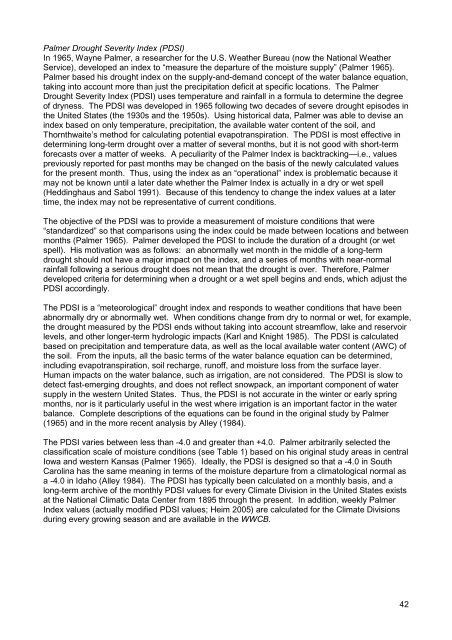Agricultural Drought Indices - US Department of Agriculture
Agricultural Drought Indices - US Department of Agriculture
Agricultural Drought Indices - US Department of Agriculture
Create successful ePaper yourself
Turn your PDF publications into a flip-book with our unique Google optimized e-Paper software.
Palmer <strong>Drought</strong> Severity Index (PDSI)<br />
In 1965, Wayne Palmer, a researcher for the U.S. Weather Bureau (now the National Weather<br />
Service), developed an index to “measure the departure <strong>of</strong> the moisture supply” (Palmer 1965).<br />
Palmer based his drought index on the supply-and-demand concept <strong>of</strong> the water balance equation,<br />
taking into account more than just the precipitation deficit at specific locations. The Palmer<br />
<strong>Drought</strong> Severity Index (PDSI) uses temperature and rainfall in a formula to determine the degree<br />
<strong>of</strong> dryness. The PDSI was developed in 1965 following two decades <strong>of</strong> severe drought episodes in<br />
the United States (the 1930s and the 1950s). Using historical data, Palmer was able to devise an<br />
index based on only temperature, precipitation, the available water content <strong>of</strong> the soil, and<br />
Thornthwaite’s method for calculating potential evapotranspiration. The PDSI is most effective in<br />
determining long-term drought over a matter <strong>of</strong> several months, but it is not good with short-term<br />
forecasts over a matter <strong>of</strong> weeks. A peculiarity <strong>of</strong> the Palmer Index is backtracking—i.e., values<br />
previously reported for past months may be changed on the basis <strong>of</strong> the newly calculated values<br />
for the present month. Thus, using the index as an “operational” index is problematic because it<br />
may not be known until a later date whether the Palmer Index is actually in a dry or wet spell<br />
(Heddinghaus and Sabol 1991). Because <strong>of</strong> this tendency to change the index values at a later<br />
time, the index may not be representative <strong>of</strong> current conditions.<br />
The objective <strong>of</strong> the PDSI was to provide a measurement <strong>of</strong> moisture conditions that were<br />
“standardized” so that comparisons using the index could be made between locations and between<br />
months (Palmer 1965). Palmer developed the PDSI to include the duration <strong>of</strong> a drought (or wet<br />
spell). His motivation was as follows: an abnormally wet month in the middle <strong>of</strong> a long-term<br />
drought should not have a major impact on the index, and a series <strong>of</strong> months with near-normal<br />
rainfall following a serious drought does not mean that the drought is over. Therefore, Palmer<br />
developed criteria for determining when a drought or a wet spell begins and ends, which adjust the<br />
PDSI accordingly.<br />
The PDSI is a “meteorological” drought index and responds to weather conditions that have been<br />
abnormally dry or abnormally wet. When conditions change from dry to normal or wet, for example,<br />
the drought measured by the PDSI ends without taking into account streamflow, lake and reservoir<br />
levels, and other longer-term hydrologic impacts (Karl and Knight 1985). The PDSI is calculated<br />
based on precipitation and temperature data, as well as the local available water content (AWC) <strong>of</strong><br />
the soil. From the inputs, all the basic terms <strong>of</strong> the water balance equation can be determined,<br />
including evapotranspiration, soil recharge, run<strong>of</strong>f, and moisture loss from the surface layer.<br />
Human impacts on the water balance, such as irrigation, are not considered. The PDSI is slow to<br />
detect fast-emerging droughts, and does not reflect snowpack, an important component <strong>of</strong> water<br />
supply in the western United States. Thus, the PDSI is not accurate in the winter or early spring<br />
months, nor is it particularly useful in the west where irrigation is an important factor in the water<br />
balance. Complete descriptions <strong>of</strong> the equations can be found in the original study by Palmer<br />
(1965) and in the more recent analysis by Alley (1984).<br />
The PDSI varies between less than -4.0 and greater than +4.0. Palmer arbitrarily selected the<br />
classification scale <strong>of</strong> moisture conditions (see Table 1) based on his original study areas in central<br />
Iowa and western Kansas (Palmer 1965). Ideally, the PDSI is designed so that a -4.0 in South<br />
Carolina has the same meaning in terms <strong>of</strong> the moisture departure from a climatological normal as<br />
a -4.0 in Idaho (Alley 1984). The PDSI has typically been calculated on a monthly basis, and a<br />
long-term archive <strong>of</strong> the monthly PDSI values for every Climate Division in the United States exists<br />
at the National Climatic Data Center from 1895 through the present. In addition, weekly Palmer<br />
Index values (actually modified PDSI values; Heim 2005) are calculated for the Climate Divisions<br />
during every growing season and are available in the WWCB.<br />
42

















